Future of Aged Care: Development Strategies for an Aging Population
VerifiedAdded on 2023/06/15
|11
|988
|165
Report
AI Summary
This report examines the current state of the aged care industry and proposes strategies for future development. It highlights the increasing life expectancy and the need for improved care services. The report outlines three key objectives: developing a technology roadmap to integrate technology into service delivery, creating policies to increase funding for aged care services through both governmental and private sector initiatives, and developing a trained workforce with comprehensive knowledge of the needs of the elderly. Recommendations include promoting remote care systems through telehealth, establishing policies for increased funding, and prioritizing workforce training to enhance the quality of life for aged individuals. The vision emphasizes technology development, increased funding, and a highly trained workforce in the aged care industry.

AGED CARE INDUSTRY
Paraphrase This Document
Need a fresh take? Get an instant paraphrase of this document with our AI Paraphraser
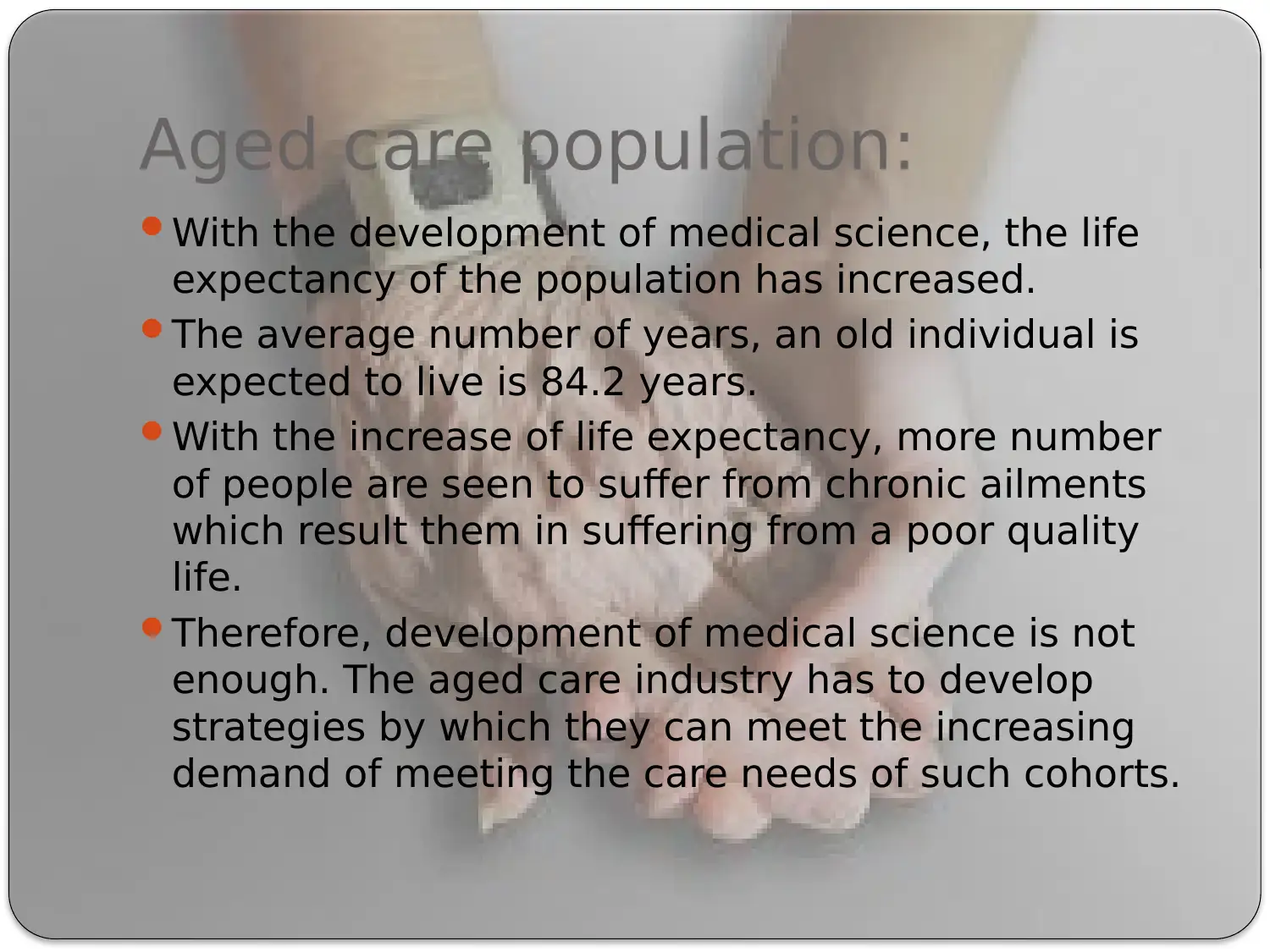
Aged care population:
With the development of medical science, the life
expectancy of the population has increased.
The average number of years, an old individual is
expected to live is 84.2 years.
With the increase of life expectancy, more number
of people are seen to suffer from chronic ailments
which result them in suffering from a poor quality
life.
Therefore, development of medical science is not
enough. The aged care industry has to develop
strategies by which they can meet the increasing
demand of meeting the care needs of such cohorts.
With the development of medical science, the life
expectancy of the population has increased.
The average number of years, an old individual is
expected to live is 84.2 years.
With the increase of life expectancy, more number
of people are seen to suffer from chronic ailments
which result them in suffering from a poor quality
life.
Therefore, development of medical science is not
enough. The aged care industry has to develop
strategies by which they can meet the increasing
demand of meeting the care needs of such cohorts.

Objective number 1
Develop a technology roadmap which
will help to make the technology, a
part of service delivery. It will help in
developing a network which will link
consumers, providers as well as
technology developers to establish
remote connections among each
others.
Develop a technology roadmap which
will help to make the technology, a
part of service delivery. It will help in
developing a network which will link
consumers, providers as well as
technology developers to establish
remote connections among each
others.
⊘ This is a preview!⊘
Do you want full access?
Subscribe today to unlock all pages.

Trusted by 1+ million students worldwide

Objective number 2
Develop policies where both
governmental sectors and private
sectors will take initiatives for raising
fund for aged care services.
Both public and private aged care
organizations should be encouraged to
invest and grow. This will not only
expand the delivery of care service
but will also provide diverse and
rewarding career options for the
youths.
Develop policies where both
governmental sectors and private
sectors will take initiatives for raising
fund for aged care services.
Both public and private aged care
organizations should be encouraged to
invest and grow. This will not only
expand the delivery of care service
but will also provide diverse and
rewarding career options for the
youths.
Paraphrase This Document
Need a fresh take? Get an instant paraphrase of this document with our AI Paraphraser
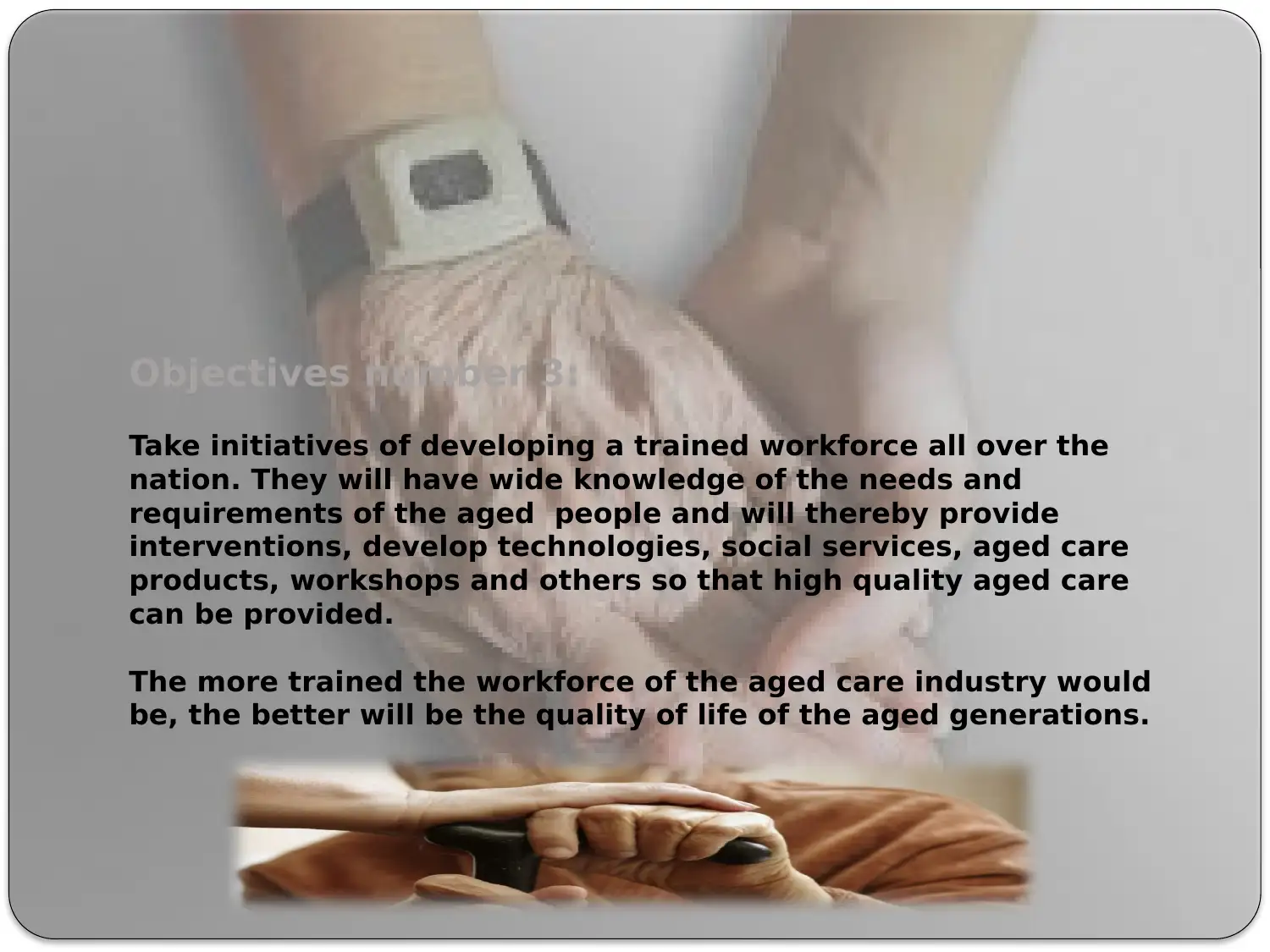
Objectives number 3:
Take initiatives of developing a trained workforce all over the
nation. They will have wide knowledge of the needs and
requirements of the aged people and will thereby provide
interventions, develop technologies, social services, aged care
products, workshops and others so that high quality aged care
can be provided.
The more trained the workforce of the aged care industry would
be, the better will be the quality of life of the aged generations.
Take initiatives of developing a trained workforce all over the
nation. They will have wide knowledge of the needs and
requirements of the aged people and will thereby provide
interventions, develop technologies, social services, aged care
products, workshops and others so that high quality aged care
can be provided.
The more trained the workforce of the aged care industry would
be, the better will be the quality of life of the aged generations.
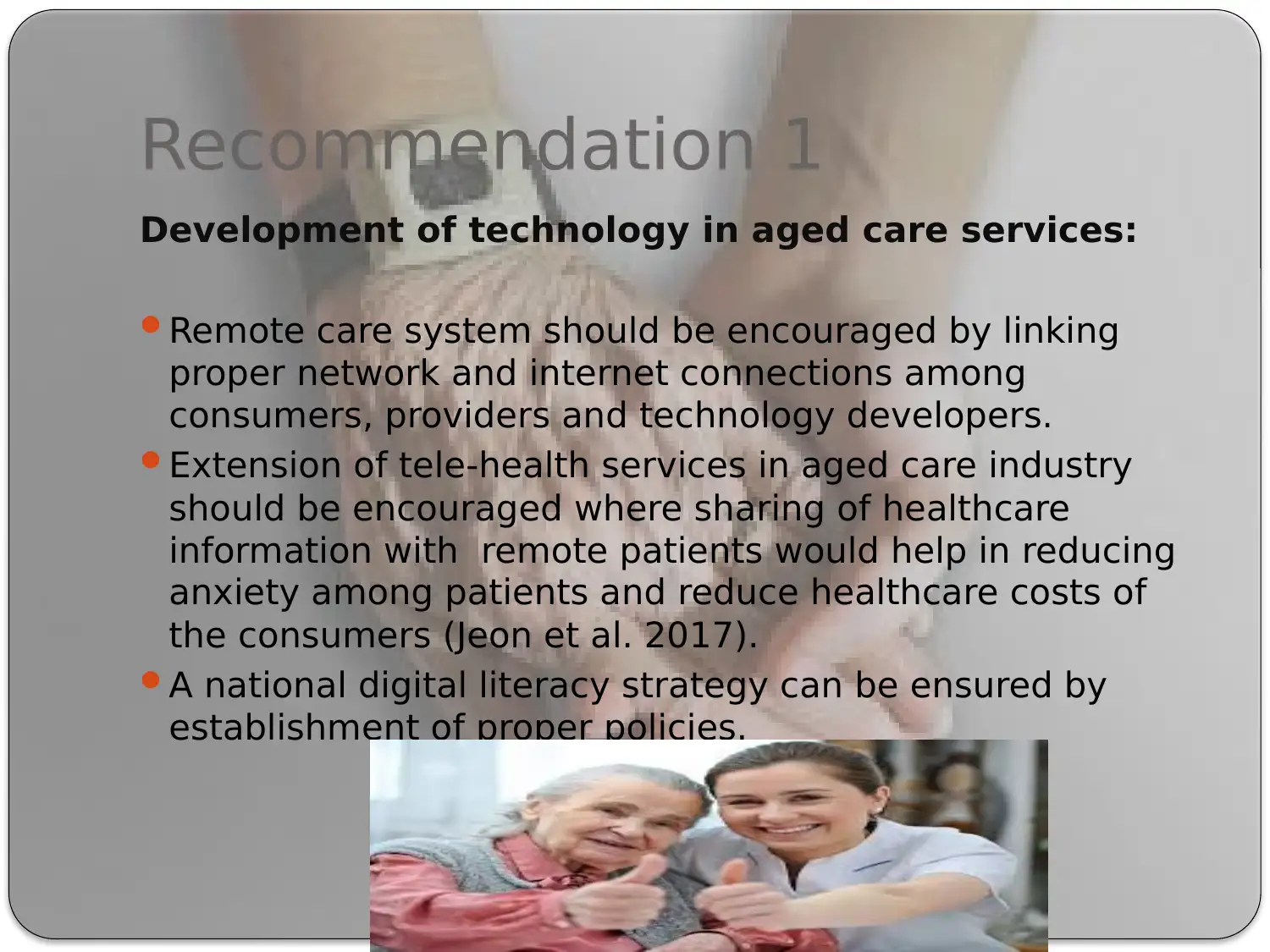
Recommendation 1
Development of technology in aged care services:
Remote care system should be encouraged by linking
proper network and internet connections among
consumers, providers and technology developers.
Extension of tele-health services in aged care industry
should be encouraged where sharing of healthcare
information with remote patients would help in reducing
anxiety among patients and reduce healthcare costs of
the consumers (Jeon et al. 2017).
A national digital literacy strategy can be ensured by
establishment of proper policies.
Development of technology in aged care services:
Remote care system should be encouraged by linking
proper network and internet connections among
consumers, providers and technology developers.
Extension of tele-health services in aged care industry
should be encouraged where sharing of healthcare
information with remote patients would help in reducing
anxiety among patients and reduce healthcare costs of
the consumers (Jeon et al. 2017).
A national digital literacy strategy can be ensured by
establishment of proper policies.
⊘ This is a preview!⊘
Do you want full access?
Subscribe today to unlock all pages.

Trusted by 1+ million students worldwide
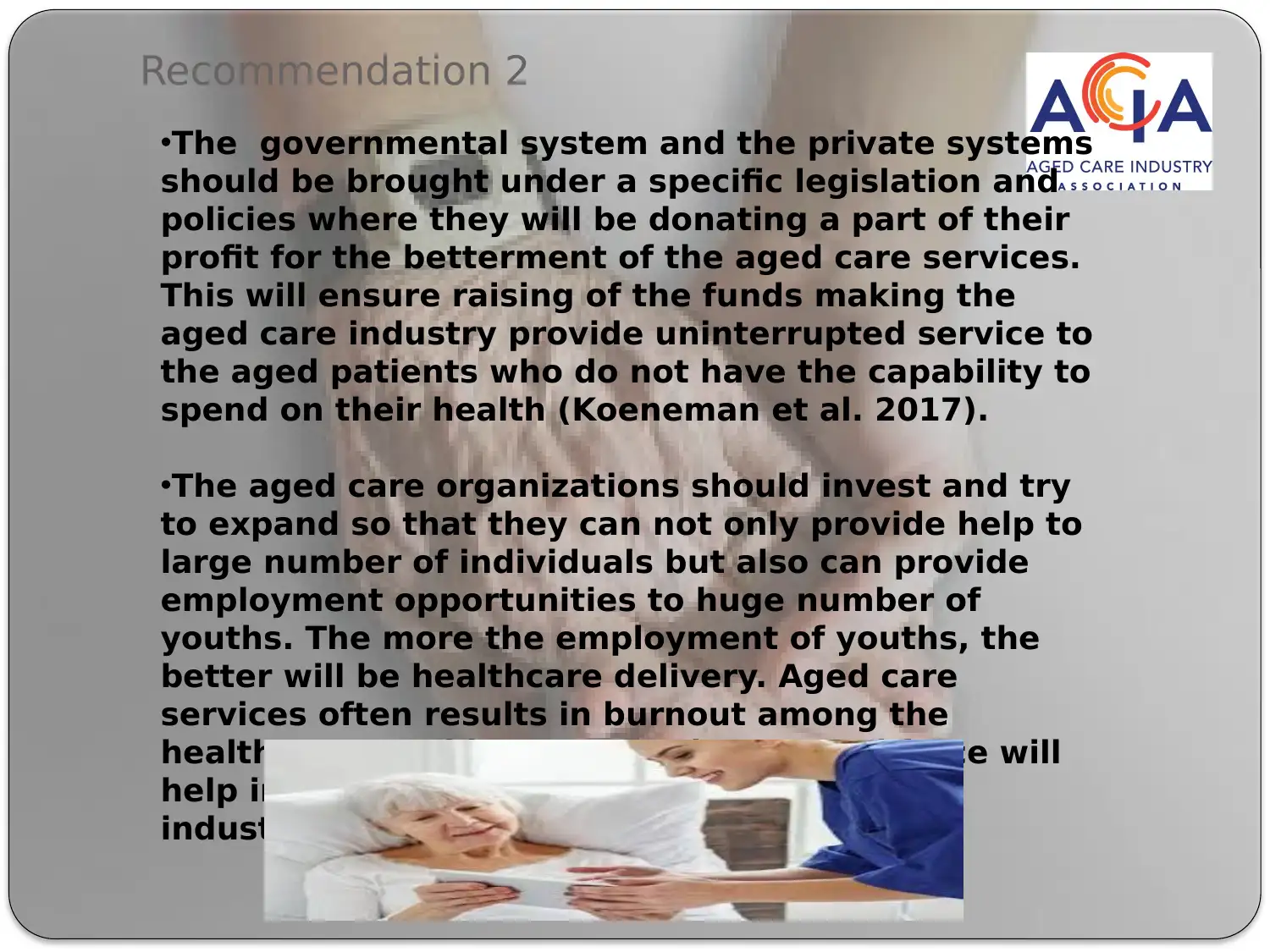
Recommendation 2
•The governmental system and the private systems
should be brought under a specific legislation and
policies where they will be donating a part of their
profit for the betterment of the aged care services.
This will ensure raising of the funds making the
aged care industry provide uninterrupted service to
the aged patients who do not have the capability to
spend on their health (Koeneman et al. 2017).
•The aged care organizations should invest and try
to expand so that they can not only provide help to
large number of individuals but also can provide
employment opportunities to huge number of
youths. The more the employment of youths, the
better will be healthcare delivery. Aged care
services often results in burnout among the
healthcare providers. Hence, larger workforce will
help in developing the face of the aged care
industries.
•The governmental system and the private systems
should be brought under a specific legislation and
policies where they will be donating a part of their
profit for the betterment of the aged care services.
This will ensure raising of the funds making the
aged care industry provide uninterrupted service to
the aged patients who do not have the capability to
spend on their health (Koeneman et al. 2017).
•The aged care organizations should invest and try
to expand so that they can not only provide help to
large number of individuals but also can provide
employment opportunities to huge number of
youths. The more the employment of youths, the
better will be healthcare delivery. Aged care
services often results in burnout among the
healthcare providers. Hence, larger workforce will
help in developing the face of the aged care
industries.
Paraphrase This Document
Need a fresh take? Get an instant paraphrase of this document with our AI Paraphraser
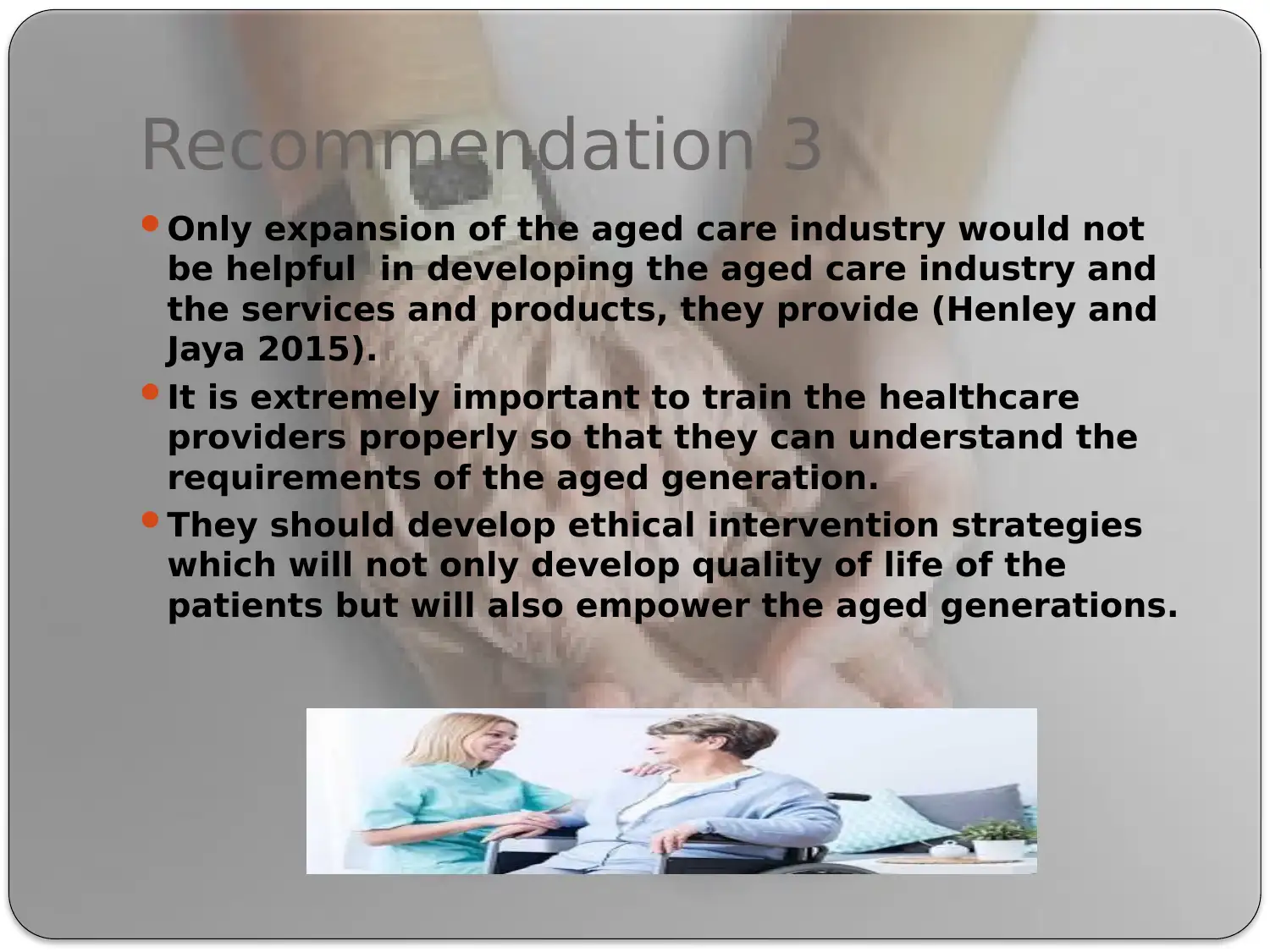
Recommendation 3
Only expansion of the aged care industry would not
be helpful in developing the aged care industry and
the services and products, they provide (Henley and
Jaya 2015).
It is extremely important to train the healthcare
providers properly so that they can understand the
requirements of the aged generation.
They should develop ethical intervention strategies
which will not only develop quality of life of the
patients but will also empower the aged generations.
Only expansion of the aged care industry would not
be helpful in developing the aged care industry and
the services and products, they provide (Henley and
Jaya 2015).
It is extremely important to train the healthcare
providers properly so that they can understand the
requirements of the aged generation.
They should develop ethical intervention strategies
which will not only develop quality of life of the
patients but will also empower the aged generations.
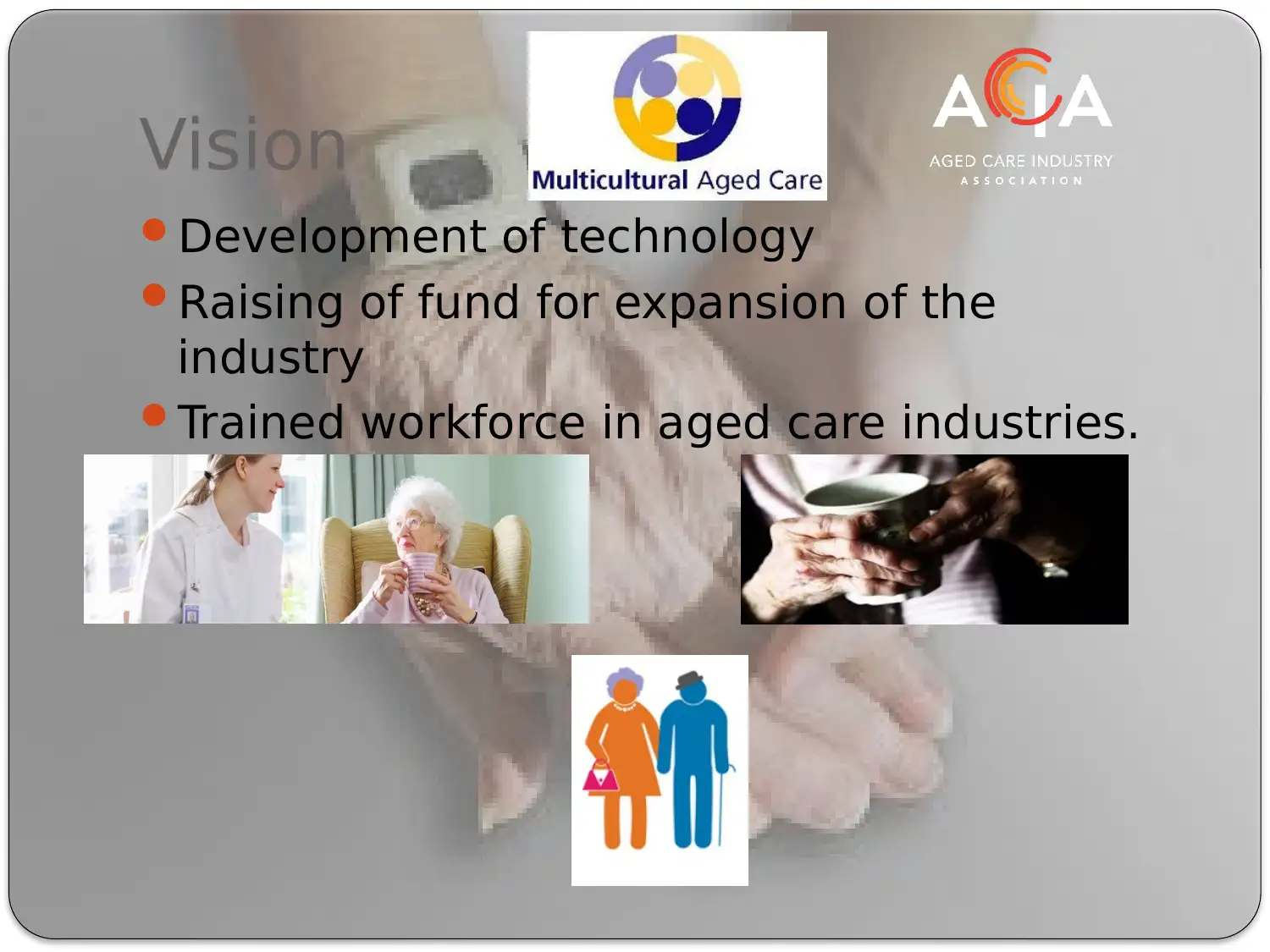
Vision
Development of technology
Raising of fund for expansion of the
industry
Trained workforce in aged care industries.
Development of technology
Raising of fund for expansion of the
industry
Trained workforce in aged care industries.
⊘ This is a preview!⊘
Do you want full access?
Subscribe today to unlock all pages.

Trusted by 1+ million students worldwide

References:
Acia.asn.au (2018). About. [online] Acia.asn.au. Available at: https://www.acia.asn.au/about [Accessed 8 Feb.
2018].
Bankwest.com.au (2018). Aged Care Residential Services Industry Report. [online] Bankwest.com.au.
Available at: https://www.bankwest.com.au/Blob/pdf/1292539844466/aged-care---bus-insights-pdf.pdf?pdf-
link=docdetail [Accessed 8 Feb. 2018].
Compositeglobal.com (2018). THERMOMASS for the growing Aged Care Industry - Concrete Insulation
Products and Solutions -Composite Global Solutions – Insulation. [online] Compositeglobal.com. Available at:
http://www.compositeglobal.com/uncategorized/thermomass-for-the-growing-aged-care-industry [Accessed 8
Feb. 2018].
deloitte.com (2018). Retirement living and residential aged care among 25 reasons to be confident about
growth | Deloitte Australia | Lucky Country series. [online] Deloitte Australia. Available at:
https://www2.deloitte.com/au/en/pages/media-releases/articles/retirement-living-residential-aged-care-
confident-growth-240314.html [Accessed 8 Feb. 2018].
Henley, B. and Jaye, C., 2015. Doing aged residential care better: the view from the trenches. The New
Zealand Medical Student Journal, (21), pp.7-11.
Ibisworld.com.au (2018). Aged Care Residential Services – Australia Industry Report | IBISWorld. [online]
Ibisworld.com.au. Available at: https://www.ibisworld.com.au/industry-trends/market-research-reports/health-
care-social-assistance/aged-care-residential-services.html [Accessed 8 Feb. 2018].
Jeon, Y.H., Merlyn, T., Sansoni, E. and Glasgow, N., 2017. Optimising the residential aged care workforce:
leadership & management study.
Koeneman, M.A., Chorus, A., Hopman-Rock, M. and Chinapaw, M.J., 2017. A novel method to promote physical
activity among older adults in residential care: an exploratory field study on implicit social norms. BMC
geriatrics, 17(1), p.8.
Nationalseniors.com.au (2018). The Future of Aged Care in Australia. [online] Nationalseniors.com.au.
Available at: https://nationalseniors.com.au/sites/default/files/Future_of_Aged_Care.pdf [Accessed 8 Feb.
2018].
Acia.asn.au (2018). About. [online] Acia.asn.au. Available at: https://www.acia.asn.au/about [Accessed 8 Feb.
2018].
Bankwest.com.au (2018). Aged Care Residential Services Industry Report. [online] Bankwest.com.au.
Available at: https://www.bankwest.com.au/Blob/pdf/1292539844466/aged-care---bus-insights-pdf.pdf?pdf-
link=docdetail [Accessed 8 Feb. 2018].
Compositeglobal.com (2018). THERMOMASS for the growing Aged Care Industry - Concrete Insulation
Products and Solutions -Composite Global Solutions – Insulation. [online] Compositeglobal.com. Available at:
http://www.compositeglobal.com/uncategorized/thermomass-for-the-growing-aged-care-industry [Accessed 8
Feb. 2018].
deloitte.com (2018). Retirement living and residential aged care among 25 reasons to be confident about
growth | Deloitte Australia | Lucky Country series. [online] Deloitte Australia. Available at:
https://www2.deloitte.com/au/en/pages/media-releases/articles/retirement-living-residential-aged-care-
confident-growth-240314.html [Accessed 8 Feb. 2018].
Henley, B. and Jaye, C., 2015. Doing aged residential care better: the view from the trenches. The New
Zealand Medical Student Journal, (21), pp.7-11.
Ibisworld.com.au (2018). Aged Care Residential Services – Australia Industry Report | IBISWorld. [online]
Ibisworld.com.au. Available at: https://www.ibisworld.com.au/industry-trends/market-research-reports/health-
care-social-assistance/aged-care-residential-services.html [Accessed 8 Feb. 2018].
Jeon, Y.H., Merlyn, T., Sansoni, E. and Glasgow, N., 2017. Optimising the residential aged care workforce:
leadership & management study.
Koeneman, M.A., Chorus, A., Hopman-Rock, M. and Chinapaw, M.J., 2017. A novel method to promote physical
activity among older adults in residential care: an exploratory field study on implicit social norms. BMC
geriatrics, 17(1), p.8.
Nationalseniors.com.au (2018). The Future of Aged Care in Australia. [online] Nationalseniors.com.au.
Available at: https://nationalseniors.com.au/sites/default/files/Future_of_Aged_Care.pdf [Accessed 8 Feb.
2018].
Paraphrase This Document
Need a fresh take? Get an instant paraphrase of this document with our AI Paraphraser
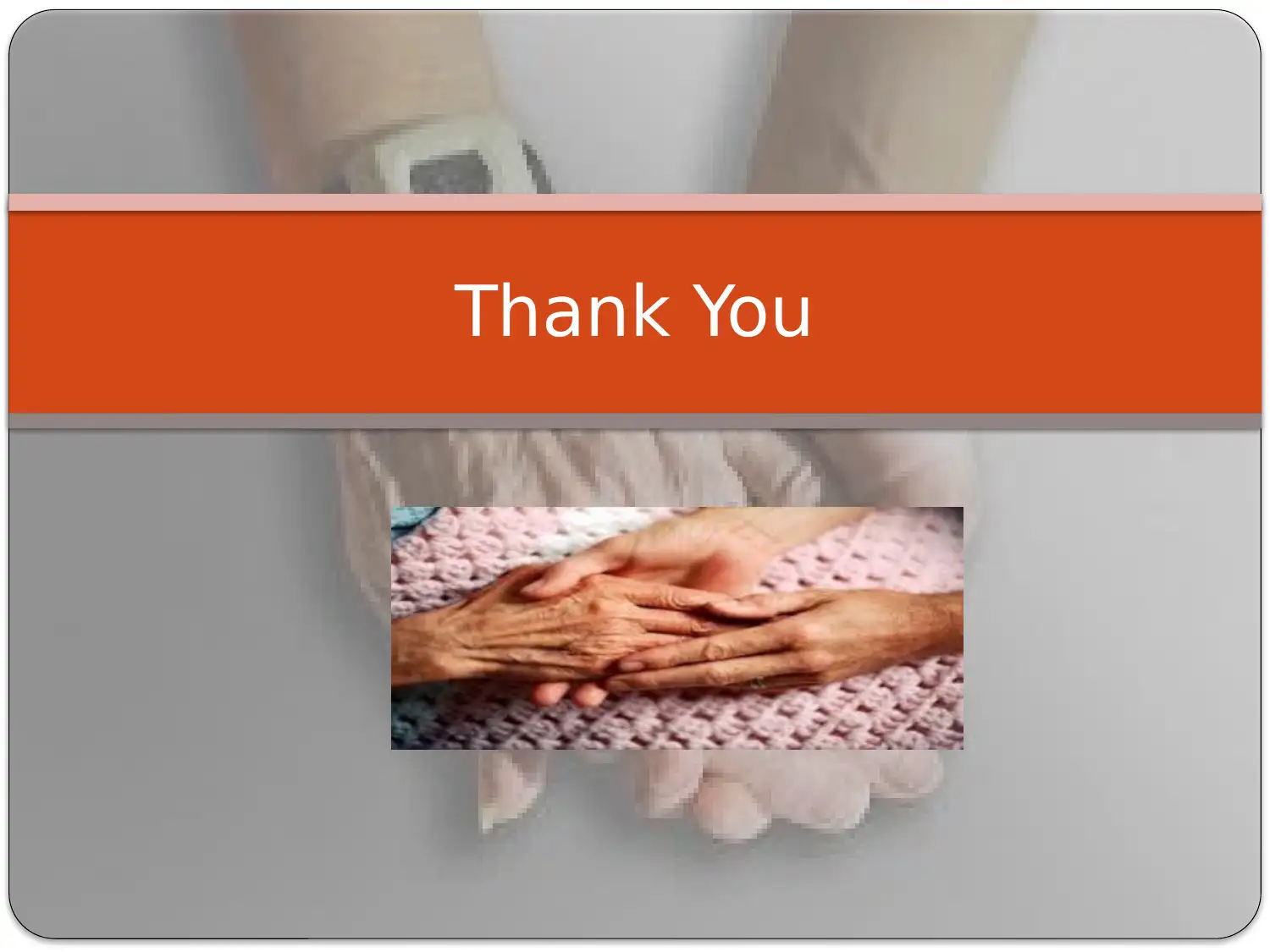
Thank You
1 out of 11
Related Documents
Your All-in-One AI-Powered Toolkit for Academic Success.
+13062052269
info@desklib.com
Available 24*7 on WhatsApp / Email
![[object Object]](/_next/static/media/star-bottom.7253800d.svg)
Unlock your academic potential
Copyright © 2020–2025 A2Z Services. All Rights Reserved. Developed and managed by ZUCOL.





